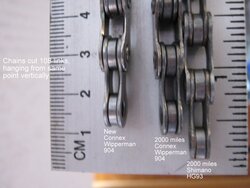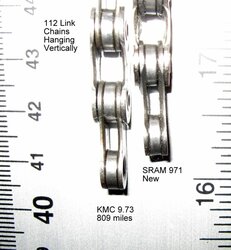Nigelnaturist
Guru
- Location
- Pontefract
Sorry.Mod note:
This disagreement about WD40 is not helping the original poster. Back on topic from here please.
Sorry.Mod note:
This disagreement about WD40 is not helping the original poster. Back on topic from here please.
You still using the same tyres ?
But mine has lasted 10000 miles at least, wouldn't be surprised if it was 2 or 3k more. On only £ shop oil & WD 40, something doesn't add up.
BTW The Discovery 501 has only had brake blocks in consumables in 10 years of use, it's still on the entire original drive chain, wheels and M+ tyres!
If you want to save money in future it is my understanding that 850 is to all intents and purposes the same chain, but with just a plating difference. Plating won't have any real effect on resistance to rust unless you are really lax on basic chain care. I understand also though that the 830 is different/poorer so best avoided.KMC Z7. I went for a SRAM PC870, which will be going on this afternoon.
Here are three things that each improved my chain condition a lot, in ease of fitting:I do ride on dusty tracks in fact I live at the bottom of a mile long farm track and my chain gets really grotty in next to no time,
I am curious to know what you were trying to achieve with this post.

That's some very high mileage for a chain. I would doubt the chain checker and measure it using a ruler. Chain checkers give a different reading when the chain is clean and when it is dirty and the difference is enough to push it over the limit when you're getting close to the limit. The ruler method on the other hand, always gives the same reading even if the chain is dirty.11 sp Ultegra chain with 3900 miles still showing less than 0.5% worn.
To be fair, only ridden in good weather conditions.
Looks good for another 500 at least.
I do not think that this is good advice. The chain will change up and down 'happily' even when worn beyond the point at which it is prudent to change it (to avoid disproportionately wearing out the cassette as well).If you have no issues in changing up and down etc just carry on and keep it.
I would doubt the chain checker and measure it using a ruler. Chain checkers give a different reading when the chain is clean and when it is dirty and the difference is enough to push it over the limit when you're getting close to the limit. The ruler method on the other hand, always gives the same reading even if the chain is dirty.
Personally I use the mm side of the 18" steel rule (which reduces the length of the smallest calibration to 0.5mm). 10 double links when new should measure 254mm and when the length gets to 255.9mm it's time to change. Given that most people will not take the chain off to measure it, measuring 14" is better than measuring 10" (ie along the bottom run rather than the top run, with the benefit that the bottom run is kept in tension by the RD spring): the relevant lengths are: 355.6mm and 100.75% of that is 358.3mm.Mathematically of course, your argument is sound. But, measurement with a crude instrument for small discrepancies is not as simply as extrapolating for a new length. The measuring error when working with a chain in-situ is large, there is a parallax error and the notion that your error is at least half of your smallest calibration. In a worst-case scenario the measuring error will therefore be larger than the elongation you're looking for. When you thus mathematically intrapolate when measuring a short section of chain, you increase the percentage error enormously. That's why the most accurate measurement is taken over the longest piece of chain possible. On a bicycle this section is available at the bottom run of the chain, when the front sprocket is large and the rear one small. This gives you an approximate 14 inch section. A good tool will take up all the available space. This is another reason why these short little commercially-available tools are inaccurate.
 [/QUOTE]
[/QUOTE] would explain it.
would explain it.

